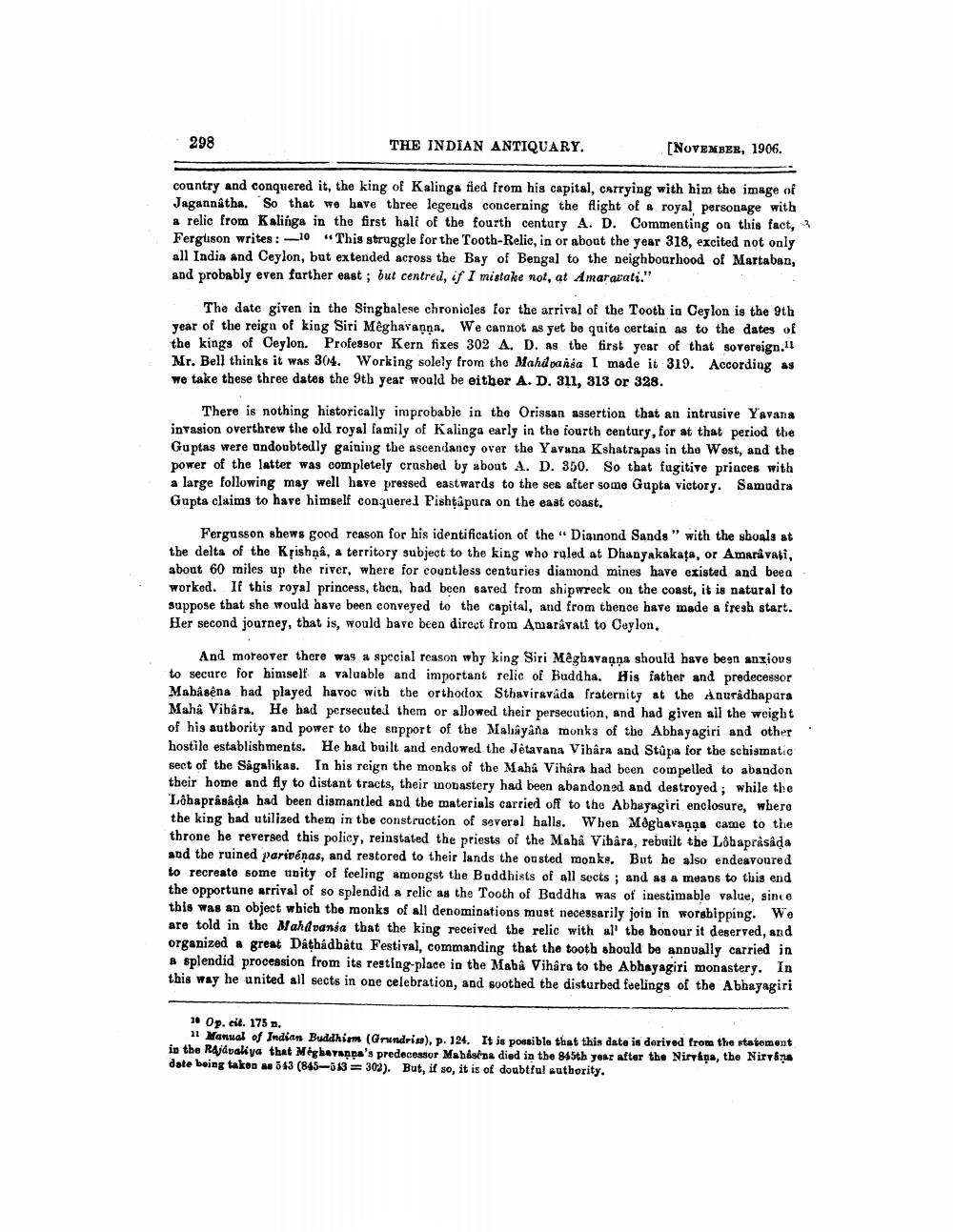________________
298
THE INDIAN ANTIQUARY.
[NOVEMBER, 1906.
country and conquered it, the king of Kalinga fled from his capital, carrying with him the image of Jagannatha. So that we have three legends concerning the flight of a royal personage with a relic from Kalinga in the first half of the fourth century A. D. Commenting on this fact, 3 Ferguson writes:10 "This struggle for the Tooth-Relic, in or about the year 318, excited not only all India and Ceylon, but extended across the Bay of Bengal to the neighbourhood of Martaban, and probably even further east; but centred, if I mistake not, at Amaravati."
The date given in the Singhalese chronicles for the arrival of the Tooth in Ceylon is the 9th year of the reign of king Siri Mêghavanna. We cannot as yet be quite certain as to the dates of the kings of Ceylon. Professor Kern fixes 302 A. D. as the first year of that sovereign." Mr. Bell thinks it was 304. Working solely from the Mahdvansa I made it 319. According as we take these three dates the 9th year would be either A. D. 311, 313 or 328.
There is nothing historically improbable in the Orissan assertion that an intrusive Yavana invasion overthrew the old royal family of Kalinga early in the fourth century, for at that period the Guptas were undoubtedly gaining the ascendancy over the Yavana Kshatrapas in the West, and the power of the latter was completely crushed by about A. D. 350. So that fugitive princes with a large following may well have pressed eastwards to the sea after some Gupta victory. Samudra Gupta claims to have himself conquered Pishțâpura on the east coast.
Fergusson shews good reason for his identification of the "Diamond Sands" with the shoals at the delta of the Krishnâ, a territory subject to the king who ruled at Dhanyakakata, or Amaravati, about 60 miles up the river, where for countless centuries diamond mines have existed and been worked. If this royal princess, then, had been saved from shipwreck on the coast, it is natural to suppose that she would have been conveyed to the capital, and from thence have made a fresh start. Her second journey, that is, would have been direct from Amaravati to Ceylon.
And moreover there was a special reason why king Siri Mêghavanna should have been anxious to secure for himself a valuable and important relic of Buddha. His father and predecessor Mahasêna had played havoc with the orthodox Sthaviravâda fraternity at the Anuradhapura Maha Vihara. He had persecuted them or allowed their persecution, and had given all the weight of his authority and power to the support of the Maliâyâña monks of the Abhayagiri and other hostile establishments. He had built and endowed the Jêtavana Vihâra and Stupa for the schismatic sect of the Sagalikas. In his reign the monks of the Maha Vihara had been compelled to abandon their home and fly to distant tracts, their monastery had been abandoned and destroyed; while the Lôhaprâsâda had been dismantled and the materials carried off to the Abhayagiri enclosure, where the king had utilized them in the construction of several halls. When Mêghavanna came to the throne he reversed this policy, reinstated the priests of the Maha Vihâra, rebuilt the Lôbaprâsâḍa and the ruined parivéņas, and restored to their lands the ousted monks. But he also endeavoured to recreate some unity of feeling amongst the Buddhists of all sects; and as a means to this end the opportune arrival of so splendid a relic as the Tooth of Buddha was of inestimable value, since this was an object which the monks of all denominations must necessarily join in worshipping. We are told in the Mahdvania that the king received the relic with all the honour it deserved, and organized a great Dâthádhatu Festival, commanding that the tooth should be annually carried in a splendid procession from its resting-place in the Maha Vihara to the Abhayagiri monastery. In this way he united all sects in one celebration, and soothed the disturbed feelings of the Abhayagiri
10 Op. cit. 175 n.
11 Manual of Indian Buddhism (Grundriss), p. 124. It is possible that this date is derived from the statement in the Rajavaliya that Méghavanna's predecessor Mahéséna died in the 845th year after the Nirvana, the Nirvana date being taken as 543 (845-513302). But, if so, it is of doubtful authority.




